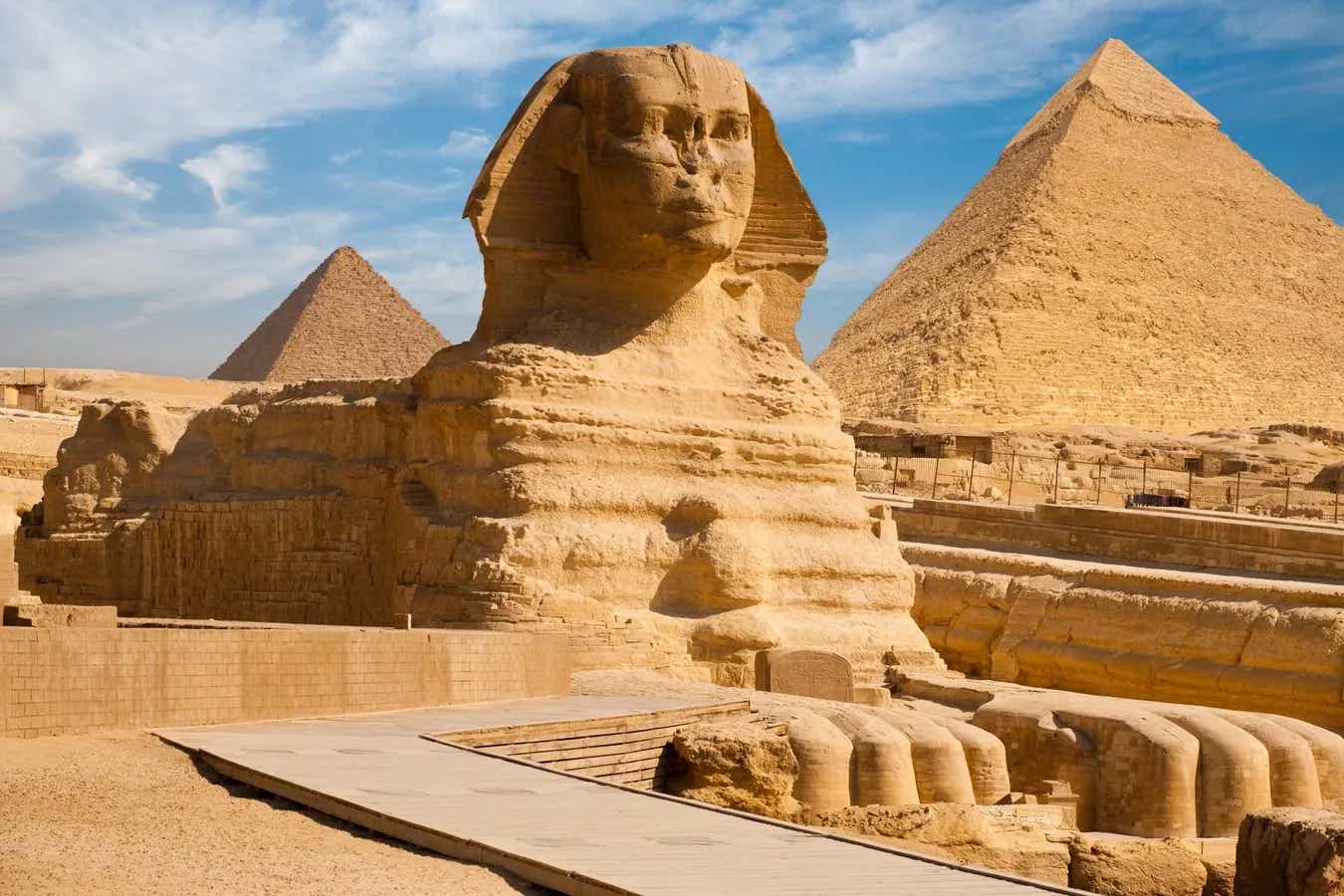Archeologists reveal the mysterious origins of the Great Sphinx of Giza
The Great Sphinx of Giza, an emblem of ancient mysticism and architectural grandeur, has stood guard over the Giza plateau for millennia.

The Great Sphinx of Giza, an emblem of ancient mysticism and architectural grandeur, has stood guard over the Giza plateau for millennia. (CREDIT: Creative Commons)
The Great Sphinx of Giza, an emblem of ancient mysticism and architectural grandeur, has stood guard over the Giza plateau for millennia. Towering against the backdrop of the pyramids, this colossal structure has spurred endless questions about its origin, purpose, and the enigma of its existence.
Historians and archaeologists have tirelessly scoured the sands of time to uncover the secrets of the Sphinx, yet a foundational puzzle persists: what landscape greeted the ancient Egyptians as they embarked on the construction of this monolithic statue, and how might the natural terrain have influenced its conception?
A riveting investigation by a cadre of New York University scientists has cast new light on this ancient riddle. By conjuring the environmental conditions that prevailed 4,500 years ago, these researchers have sought to understand the dance between natural elements and the raw stone that would become one of the world's most iconic relics.
Yardangs in Egypt's White Desert. (CREDIT: atdigit/Getty Images)
Associate Professor Leif Ristroph, from NYU’s Courant Institute of Mathematical Sciences, leads the inquiry with a groundbreaking approach. His team's research, slated for publication in the prestigious journal Physical Review Fluids, ventures into the genesis of the Sphinx's form through the lens of erosion.
"Our findings offer a possible ‘origin story’ for how Sphinx-like formations can come about from erosion," Ristroph shares with a sense of discovery. "Our laboratory experiments showed that surprisingly Sphinx-like shapes can, in fact, come from materials being eroded by fast flows."
The cornerstone of their research is the replication of yardangs – peculiar desert rock structures sculpted by relentless winds.
Related Stories
These natural phenomena provide a clue to the potential beginnings of the Great Sphinx, hypothesizing it as an ancient yardang that human hands later refined into the majestic form we recognize today.
To recreate these conditions, Ristroph and his team at the NYU’s Applied Mathematics Laboratory delved into a series of sophisticated experiments. They crafted mounds from soft clay with embedded harder materials, emulating the geological makeup of northeastern Egypt, the Sphinx’s home.
Through their efforts, they unleashed a torrent of fast-flowing water, an analog to the wind that etched the desert’s face, to observe how it might carve similar structures.
Courant researchers have determined how Sphinx-like shapes are formed. (CREDIT: Pavel Muravev/Getty Images)
As the artificial elements took their toll on the clay mounds, a lab-created Sphinx emerged. The resistant materials within the clay refused to yield, forming what would become the 'head' of the lion, while softer areas around it were gradually worn away to reveal a pronounced 'neck,' the stretch of 'paws,' and the curve of an 'arched back.'
The experiment's striking result was an echo of the Sphinx, chiseled not by human hands but by the fluid mechanics of erosion. The image accompanying this research, provided by NYU's Applied Mathematics Laboratory, encapsulates this journey from formless clay to a figure that mirrors the ancient guardian of Egypt.
A lab Sphinx is carved through an experiment that replicates the wind moving against once-shapeless mounds of clay, with harder material becoming the “head” of the lion and other features—such as an undercut “neck,” “paws” laid out in front on the ground, and arched “back”—developing. (CREDIT: NYU's Applied Mathematics Laboratory)
"Our results provide a simple origin theory for how Sphinx-like formations can come about from erosion," Ristroph notes, emphasizing the broader implications of the study. Indeed, yardangs that bear a resemblance to seated or reclining animals exist today, bolstering the credibility of the team's findings.
This research not only pierces the veil of history but also offers a wealth of knowledge to geologists. Ristroph points out, "The work may also be useful to geologists as it reveals factors that affect rock formations—namely, that they are not homogeneous or uniform in composition." It's a revelation that the interplay between different materials under erosive forces can lead to unexpected and captivating formations.
A laboratory Sphinx in the current of a water tunnel. The object is coated with clay and fluorescein dye, and the photograph captures the “streak volume” or 3D region of flow that has at some time entered the boundary layer and eroded the surface. (CREDIT: NYU's Applied Mathematics Laboratory)
Joining Ristroph in this scholarly endeavor are Samuel Boury, engaged as a postdoctoral researcher during the study, and Scott Weady, an NYU doctoral student at the time.
Together, their collaborative effort has penned a new chapter in our understanding of the Great Sphinx's story, suggesting that the winds of time and nature's artistry may have been the first sculptors to shape its enigmatic presence.
The essence of their work extends beyond the past; it's a testament to the enduring quest for knowledge and the sophisticated techniques scientists employ to decipher the whispers of history. This exploration into the Sphinx's origins renews our fascination with a civilization that continues to captivate the human imagination and underscores the profound impact of natural processes in shaping our world's wonders.
The team's innovative experiment and resultant findings advance the dialogue between past and present, between science and the riddles of antiquity.
The Great Sphinx, ever silent, may hold its secrets still, but the relentless pursuit of understanding by scholars like Ristroph and his colleagues brings us ever closer to unraveling the mysteries locked within its stony gaze.
Note: Materials provided above by The Brighter Side of News. Content may be edited for style and length.
Like these kind of feel good stories? Get the Brighter Side of News' newsletter.
Joseph Shavit
Science News Writer, Editor-At-Large and Publisher
Joseph Shavit, based in Los Angeles, is a seasoned science journalist, editor and co-founder of The Brighter Side of News, where he transforms complex discoveries into clear, engaging stories for general readers. With experience at major media groups like Times Mirror and Tribune, he writes with both authority and curiosity. His work spans astronomy, physics, quantum mechanics, climate change, artificial intelligence, health, and medicine. Known for linking breakthroughs to real-world markets, he highlights how research transitions into products and industries that shape daily life.



